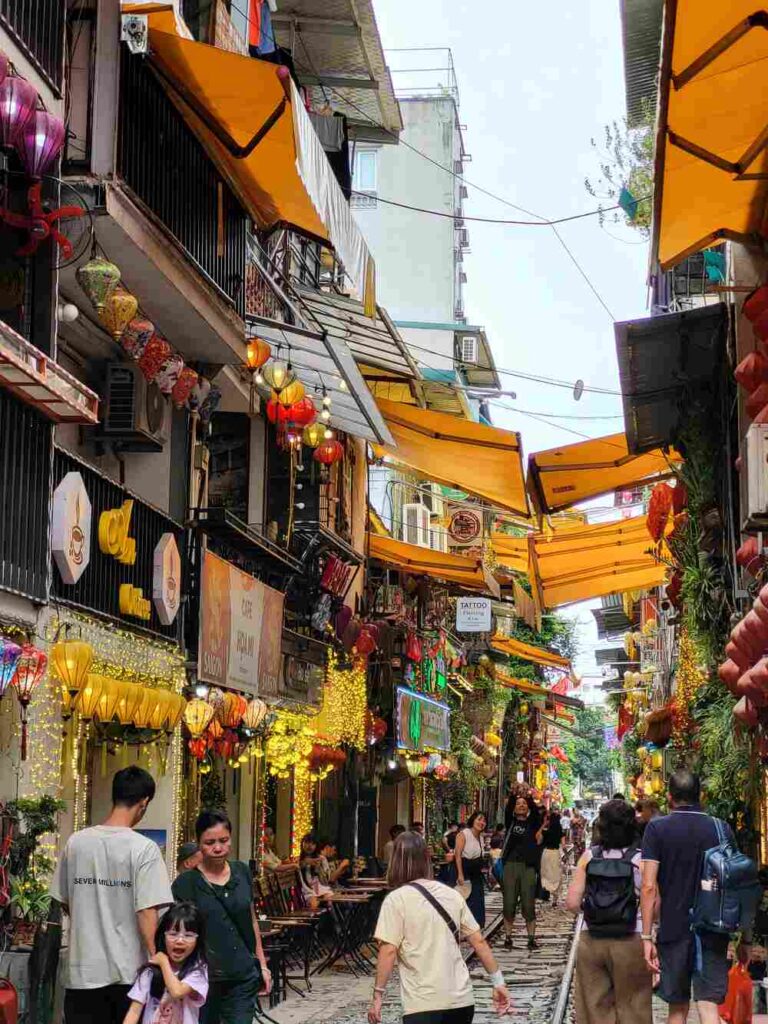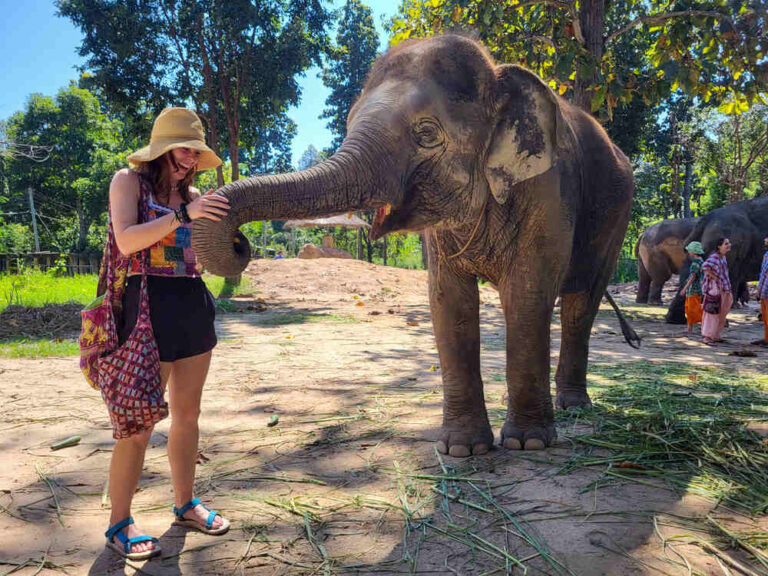When traveling, a little bit of local language knowledge can go a long way, and Spanish is one of the most useful languages you can learn.
I like to make language cheat sheets for myself when I travel to a foreign country. They are like little business cards for me to reference when I want to try to communicate with locals, and they have always been handy.

For that reason, I have made this list of useful Spanish travel phrases I used most when traveling through South America.
Below are some essential Spanish words and phrases that are super helpful for everyday travel situations in any Spanish-speaking country. It covers basic Spanish phrases, greetings, ordering at restaurants, getting around, and a few polite phrases that always bring a smile.
*I would like to note, I am not a native Spanish speaker. This is a travel cheat sheet I have made for myself and found useful. So I wanted to share it for others.
Traveling language cheat sheets are important
Learning a bit of the local language while traveling is a meaningful way to show respect and genuine curiosity about other cultures.
I’ve found that even when my pronunciation was off (sometimes hilariously so), making the effort to speak a few words in the local language often led to more authentic, memorable, and sometimes downright funny interactions.
Some of my favorite travel memories came from the moments when I didn’t fully understand the words, but still shared laughs or heartwarming exchanges with locals. That’s the magic of language: it doesn’t have to be perfect to be powerful.
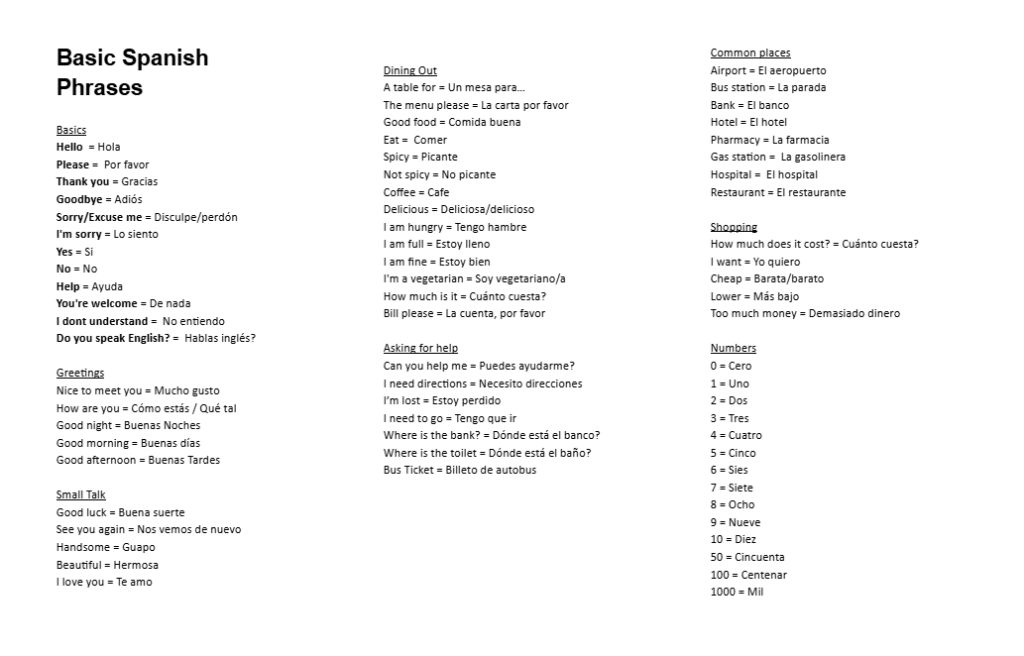
I love putting together these little language cheat sheets (I also have one for Vietnamese and Thai). I hope this one, packed with essential Spanish travel phrases, makes your journey smoother, richer, and more enjoyable!
Why knowing some Spanish for traveling is helpful
Spanish is the official language in over 20 countries and is widely understood in many more. Picking up a few phrases can really help you in a huge variety of destinations across Latin America, Europe, and parts of the United States.
Another bonus? Spanish is closely related to several other languages like Italian, Portuguese, and French. So, learning some Spanish basics can actually make it easier to pick up words in these languages too.
Where Spanish is spoken around the world
Spanish is the official language of over twenty countries. Below is the list of Spanish-speaking countries around the world:
- Argentina
- Bolivia
- Chile
- Colombia
- Costa Rica
- Cuba
- Dominican Republic
- Ecuador
- El Salvadore
- Equatorial Guinea
- Guatemala
- Honduras
- Mexico
- Nicaragua
- Panama
- Paraguay
- Peru
- Spain
- Uruguay
- Venezuela
Spanish is also widely spoken in many more.
Key Differences Between Spanish and English
Spanish and English differ in several important ways, particularly in spelling, grammar, and pronunciation.
Spelling in Spanish is generally more phonetic than in English. This means that words are typically spelled the way they sound, making pronunciation more consistent. In contrast, English often features irregular and unpredictable spelling patterns.
Grammar in Spanish can be more complex, especially when it comes to noun gender and verb conjugation. Spanish nouns are either masculine or feminine, and many words change form depending on the gender and the subject being referenced in a sentence.
Basic Spanish phrases for travel
Learning a new language starts with a few key phrases. This is a list of the most useful Spanish phrases and words I use when traveling, so I like to include them at the top. I usually use a combination of multiple of these words in everyday conversations. They’re also the pretty basic first steps in learning Spanish (or any language).
Hello = Hola
Please = Por favor
Thank you = Gracias
Goodbye = Adiós
Sorry/Excuse me = Disculpe/perdón
I’m sorry = Lo siento
Yes = Si
No = No
Help = Ayuda
You’re welcome = De nada
I dont understand = no entiendo
Do you speak English? = Hablas inglés?
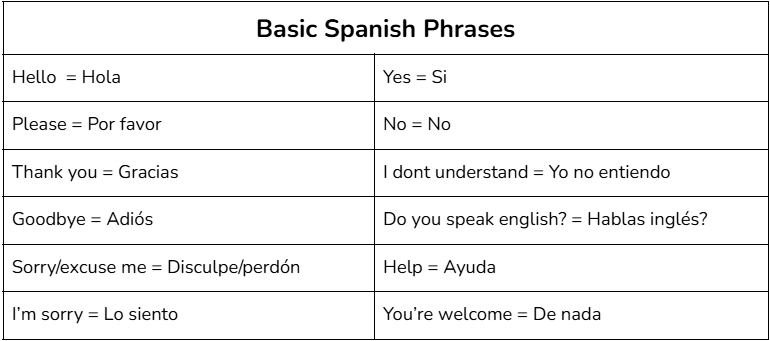
Greetings
Knowing a few Spanish greetings can go a long way. It’s a simple way to show respect, break the ice, and connect with locals. Plus, greetings are often the first words you’ll use in any conversation. Here are the most common:
Nice to meet you = Mucho gusto
How are you = Cómo estás / Qué tal
Good night = Buenas Noches
Good morning = Buenos días
Good afternoon = Buenas Tardes

Small talk
Good luck = Buena suerte
See you again = Nos vemos de nuevo
Handsome = Guapo
Beautiful = Hermosa
I love you = Te amo

Dining out
I believe food is the best part of exploring cultures, so dining out to experience the local cuisine is essential. Here are a few common phrases that help me communicate and order when at a restaurant.
A table for = Un mesa para…
The menu please = La carta por favor
Good food = Comida buena
Eat = Comer
Spicy = Picante
Not spicy = No picante
Coffee = Cafe
Delicious = Deliciosa/delicioso
I am hungry = Tengo hambre
I am full = Estoy lleno
I am fine = Estoy bien
I’m a vegetarian = Soy vegetariano/a
How much is it = Cuánto cuesta?
Bill please = La cuenta, por favor
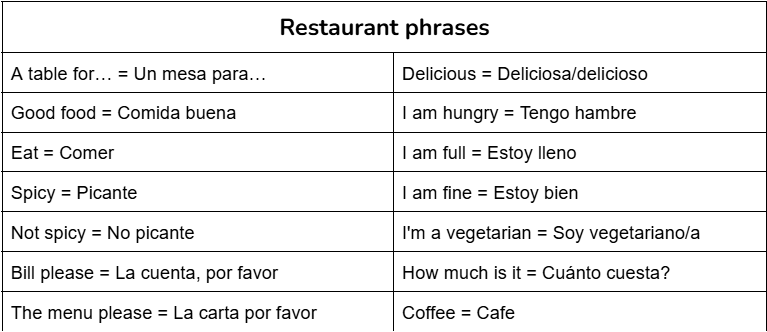
Asking for help
Asking for help is a common occurrence when traveling (at least for me). Getting lost is part of the adventure but staying lost is never fun.
Can you help me = Puedes ayudarme?
I need directions = Necesito direcciones
I’m lost = Estoy perdido
I need to go = Tengo que ir
Where is the bank? = Dónde está el banco?
Where is the toilet = Dónde está el baño?
Bus Ticket = Billete de autobus

Common places
It’s handy to know the words of a few very common places or locations in case of an emergency situation or to ask for help.
Airport = El aeropuerto
Bus station = La parade
Bank = El banco
Hotel = El hotel
Pharmacy = La farmacia
Gas station = La gasolinera
Hospital = El hospital
Restaurant = El restaurante

Shopping
How much does it cost? = Cuánto cuesta?
I want = Yo quiero
Cheap = Barata/barato
Lower = Más bajo
Too much money = Demasiado dinero

Numbers
0 = Cero
1 = Uno
2 = Dos
3 = Tres
4 = Cuatro
5 = Cinco
6 = Sies
7 = Siete
8 = Ocho
9 = Nueve
10 = Diez
50 = Cincuenta
100 = Centenar
1000 = Mil

Tips for learning or understanding Spanish
If you just plan on learning the basics of Spanish for your travels, there is no need to do a deep dive into the learning expectations of the language, but it is still important to practice! Here are a few tips to learning some basic Spanish phrases to help you speak and understand others while away.
Focus on travel-relevant vocabulary
Start with words and phrases you’ll actually use:
- Greetings and polite expressions
- Asking for directions
- Ordering food
- Emergencies
- Use phrasebooks or print out my full Spanish cheat sheet to have on hand!

Practice speaking aloud
Speaking is essential. Repeat these phrases out loud, try imitating native speakers, or record yourself to compare pronunciation.
Practice during your travels
When you’re in a Spanish-speaking country, actually use what you know. Try to greet locals, or order your food in Spanish. Even ask simple questions in Spanish if you can, most locals appreciate the effort and may even help you improve.
Listen to Spanish every day
Exposure is key. Try listening to Spanish-language podcasts for beginners and popular Spanish music.
Conclusion
I truly believe that learning a few key Spanish words can make a world of difference in your travel experience.
Learning a foreign language can be tough, and using it in real life can be awkward or intimidating, but pushing through that initial discomfort often leads to the best travel moments.
Sure, a translation app can do all the communicating for you, but there’s something special about making the effort yourself. Even simple phrases can go a long way in helping you connect with locals, show respect for their culture, and feel more immersed in your surroundings.
I’ve put together this list of common Spanish words and phrases with travelers in mind, and I hope it helps make your next adventure even more enjoyable and meaningful!




